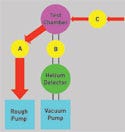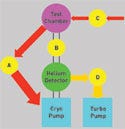Leak Detection: A New Method for Medical Electronics
TESTING
October 1, 2006
The need for reliability in implantable medical electronic devices is paramount. Quite often, a patient's health depends on the integrity and reliability of an implanted medical electronic device. Body fluids are ionic in nature, corrosive, and generally not a suitable environment for electronic devices. Providing a hermetic package for the electronics serves two purposes: it keeps body fluids away from the electronic parts, and it prevents potentially toxic substances in the electronic package from entering the body. Many electronic implantables contain batteries, which in turn contain chemicals that are not compatible with body chemistry. One major step in ensuring reliability is to accurately measure the seal of the implantable package.
Historically, leak detection for medical electronics has been done with a fine-leak detection process followed by a gross-leak detection process, as described in MIL-STD 883, Method 1014.1 This method and the procedures described within the standard have formed the basis for hermetic testing of both high-reliability semiconductors and medical electronic devices.
These conventional test procedures evolved based on the physical limitations of the test equipment available. The limited dynamic range of conventional helium leak detectors required that a secondary test procedure be developed to cover the large, or gross, leak range. Several methods have been tried, and the most commonly used procedure, referred to as the bubble test, involves submerging the package under test in a fluorocarbon bath and literally looking for bubbles. If the implantable package has a silicone rubber or epoxy coating over its metal or ceramic surface, conventional leak test procedures are extremely difficult to apply in both the fine and gross leak ranges.
Recently, a new leak detection procedure has been developed that overcomes these limitations and extends the minimum detectible leak range to less than 1.0 × 1013 atm-cc/sec for helium.2 The procedure is called cumulative helium leak detection, or CHLD. CHLD is a new approach to the detection of very fine leaks in sealed packages. It differs from previous methods in that it accumulates all leakage material from the package under test.
Traditional methods looked for evidence of leakage as a test gas was being exhausted from the chamber, but these methods did not accumulate all of the test gas. CHLD does, which means that even very small leaks will accumulate over time and become detectable. Before looking into the details of this new process, it is worthwhile to review the conventional leak detection to provide a comparison.
Conventional Helium Fine-Leak Detection
|
Figure 1. (click to enlarge) Traditional helium leak detector. |
The most common helium leak detector consists of a test chamber, vacuum system, helium detector, and display of leak rate. To determine the leak rate of a semiconductor package, the package must first be sealed with some percentage of helium inside, or the package can be placed in a helium bomb (pressurized chamber) for a period of time, removed, and then tested. A roughing pump (see Figure 1) is used to evacuate the test chamber through valve A, and then the chamber is connected to the detector through valve B. Valve C simply vents the test chamber to atmosphere to facilitate part removal.
The helium detector measures the amplitude of the resulting helium signal, which is proportional to the leak rate. If the part under test has both real and virtual leaks, an operator must make a subjective decision as to when to record the leak value. Continuous pumping on the package can evacuate the surface-adsorbed helium as well as the helium leaking out from inside the package if the leak rate is high compared with the internal volume of the package.
For the detector to function properly, the leak path must be maintained at a 3.0 × 10–3 Torr or lower pressure. Because the leaking gas is continuously pumped out of the test chamber, the largest leak detectable is about 1.0 × 10–4 atm-cc/sec, although this value is strongly dependent on the volume of the particular package under test.
The smallest leak detectable depends on the resolution of the mass analyzer and the signal-to-noise ratio of the detector. Moisture in the vacuum system can fractionate during ionization, forming species with molecular weights close to helium.3 This can affect the accuracy of helium detection and limits the minimum detectable leak to approximately 1.0 × 10–9 atm-cc/sec or greater.
The performance of most traditional helium leak detectors when measuring leaks in semiconductor or electronic packages can be summarized as
• Minimum detectable leak is 1.0 × 10–9 atm-cc/sec.
• Dynamic range is 5 decades.
• Gross leaks, or leaks greater than 1.0 × 10–4 atm-cc/sec, must be measured by an alternative method.
• Virtual leaks are subjectively assessed by the operator.
Gross-Leak Detection
Traditionally, gross-leak detection has been performed by placing the test device in a liquid perfluorocarbon (PFC) bath, using a PFC with a low boiling point. (Historically this test used chlorofluorocarbons, or CFCs. Use of CFCs in this test process has been largely replaced by the use of chemically similar, but less toxic, PFCs.) Pressure is applied to force the PFC into any possible leaks. The part is then transferred to a second, hotter, PFC bath that uses a higher-boiling-point PFC. The increased temperature in the second bath makes the first PFC boil. The gas bubbles formed become visible in the test chamber. This test method has three disadvantages:
• It can be visually difficult to detect the bubbles from small leaks or from devices with extremely small cavities.
• The test devices retain residual amounts of PFCs. This may require additional processing prior to use.
• The PFCs tend to temporarily plug extremely small leaks, thereby preventing accurate fine-leak retesting. This temporarily plugged leak can also provide a conduit for moisture intrusion later.
Cumulative Helium Leak Detection
|
Figure 2. (click to enlarge) Cumulative helium leak detector. |
The CHLD method consists of essentially the same components as traditional helium-leak detection (see Figure 2). The key difference in the CHLD methodology is that it is a closed-loop system, wherein any helium leakage accumulates over the test cycle. The basic test sequence is as follows:
• The test device is placed in a helium bomb (pressure chamber) and pressurized with helium.
• The device is then placed in the CHLD test chamber.
• A cryopump begins to evacuate the chamber, but does so not by exhausting gas but by freezing the nitrogen, oxygen, and most other atomic species.
• As the other gases freeze, only helium (if any) remains in the chamber. If there is virtually no remaining pressure, the device has not exhibited a gross leak failure. If the residual pressure is too high, the device has failed the gross-leak test.
• As the residual pressure is lowered, a mass-spectrometer is switched on in the system. It analyzes any residual gas. If there is a fine leak, helium slowly accumulates in the test chamber, and the mass spectrometer indicates a steadily rising level.
• The rate of rise is computed, thereby determining the exact leak rate.
As the sequence indicates, during the test cycle the system remains closed. Rather than looking for a spike of helium as in the traditional method, leaking helium is allowed to accumulate. Therefore, extremely small leaks can be detected over time.
Both CHLD and the traditional method use a helium detector. CHLD uses a small mass analyzer as the detector to measure other gases of interest. In particular, fluorocarbons and krypton, which are used in the manufacture of some medical devices, can be analyzed using an amplitude measurement.4,5
The vacuum system used in CHLD objectives is somewhat different from a traditional leak detector. CHLD does not use a turbo pump for roughing down the chamber; this would exhaust gases that might be of interest. Instead, a specially designed cryopump, which does not pump helium, is used to pump down the chamber. (A cryopump operates by freezing gases. There is no pump exhaust; the frozen gas accumulates in the pump chamber. CHLD uses a cryopump that is cold enough to freeze all gases except helium. It is also modified so that it does not absorb helium into any part of the pump chamber.)
Valve B can be used to leak test the part for other gases such as krypton or xenon. Valve C is used to purge the test chamber with nitrogen when loading a package to displace the ambient helium and to vent the chamber at the conclusion of the leak test.6 The turbo pump system removes the accumulated helium at the end of the test interval through valve D in preparation for the next test.
Determining Leak Rate
Gross leaks (≥1.0 atm-cc/sec) are indicated by an immediate large displacement of the helium signal and are determined within the first few seconds of the test. If there is a gross leak, the helium prevents the chamber from pumping down very far.
|
Figure 3. (click to enlarge) Helium signal versus time. |
Instead of measuring helium amplitude to determine a fine-leak rate, the CHLD method measures the rate of increase of the helium level in the chamber. The rate of increase is proportional to the leak rate. Figure 3 shows a simplified plot of the helium signal on a linear scale for various leak conditions.
So-called virtual leaks can occur with certain package types as a result of outgassed helium that was adsorbed into the surface of the package material. The CHLD method can separate virtual leaks from real leaks by analyzing the structure of the signal. Real leaks exhibit a linear increase in signal, whereas virtual leaks are exponential. When testing a package that exhibits a large virtual leak, the test interval can be extended until the rate of increase of the helium signal becomes a linear function. If the internal volume of the package is small compared with the actual leak rate, it is possible to see an exponential curve throughout the test interval. However, the exponential curve will have a positive offset, which will clearly indicate that a large leak is present.
Sensitivity and Dynamic Range
Because the helium accumulates in the chamber, CHLD can detect very low leak rates. The limit of accuracy is in the range of 1.0 × 10–13 atm-cc/sec. At this level, trace amounts of background helium and the difficulty in achieving accurate calibration limit the ultimate accuracy of CHLD. Nevertheless, this is at least 500 times more sensitive than traditional methods.
Display of Results
In addition to controlling the testing sequence automatically, the computer calculates and displays the test results. With a dynamic range from 1 atm-cc/sec to nearly 1.0 × 10–13 atm-cc, a logarithmic display is used for the operator, and the computer calculates a curve fit to separate the virtual leak rate of a package from the actual leak rate. The graph of this curve makes it easy to determine both the leak rate and whether it is a real or a virtual leak. The curve of an exponential virtual leak is visibly distinct from a real leak. The computer can also display and record tabular numerical data for traceability purposes.
The graphing feature is important when testing medical implantable devices that are encased in silicon rubber or epoxy. Medical implantable ceramic packages and metal packages with glass feed-throughs or glass windows can have significant virtual leak rates that compound the leak testing problem when using a traditional helium leak detector. The following is a summary of CHLD performance:
• Minimum detectable leak is 1.0 × 10–13 atm-cc/sec.
• Dynamic range is over 13 decades.
• One test covers the entire leak range of interest.
• Operators do not use subjective judgment to distinguish between virtual and real leaks.
CHLD has several performance advantages. It is typically about 500–1000 times more sensitive than traditional leak detectors, allowing smaller leaks to be detected. Because CHLD does not contaminate the device with fluorocarbons, it allows repeated fine-leak tests of units and allows 100% testing of all outgoing product, with no additional cleaning or decontamination steps. CHLD combines fine- and gross-leak testing into a single test, which saves time and reduces costs. The analyzer can simultaneously test for leaks of other gases, such as krypton, xenon, or fluorocarbons.
CHLD can also detect any-size leaks in extremely small packages without modifying the package. Moreover, no fluorocarbons are required for this test procedure.
Applications
A version of the CHLD system has been used to measure the hermeticity of cochlear implants and to study the problem of leak-path plugging by fluorocarbons or by water. Also, medical devices requiring accurate leak-rate measurements at ≤5.0 × 10–12 atm-cc/sec have been tested. The system uses all-metal pneumatically controlled bellows valves and the NIST calibration leak standard. The entire vacuum system is fabricated from a special 304L stainless steel. Metal seal flanges are employed wherever a connection must be made to the high-vacuum system.
Conclusion
The CHLD test method provides a highly sensitive way to measure leaks in high-reliability electronics and medical implantable packages. An operator no longer decides whether a leak is real or virtual or both. Because the test procedure covers both the fine- and gross-leak ranges in a single step, production costs can be reduced. Additional studies are now possible to characterize the ingress of moisture as a function of measured helium leak rate in a fine-leak range not previously investigated.
With the ability to measure small leaks and easily separate out the virtual-leak component, it is possible to optimize sealing procedures used in laser welding, seam sealing, and furnace brazing at leak rates previously considered immeasurable. Medical implantable electronic packages can be leak tested even though they are encapsulated with silicone rubber. Production testing of finished medical implantable electronic packages is practical.
John Pernicka is founder and president of Pernicka Corp. (Fort Collins, CO). Contact him at 970/224-0220.
References
1. MIL-STD 883, Method 1014, “Department of Defense Test Method Standard: Microcircuits,” 28 February 2006, [online] www.dscc.dla.mil/Downloads/MilSpec/Docs/MIL-STD-883/std883_1000.pdf.
2. JC Pernicka, “The Value of RGA in Semiconductor Manufacturing” (paper presented at the RGA Task Group, JEDEC/G-12 Meeting, Columbus, OH, September 8, 2003).
3. LC Beavis, “Formation of Triatomic Ions of Hydrogen in the Ion Source of Gas Analyzers,” Journal of Vacuum Science and Technology 10, no. 2 (1973): 416–417.
4. JC Pernicka, “Leak Testing to Predict RGA Failures II” (paper presented at the Small Package Hermeticity Task Group, JEDEC/G-12 Meeting, Portland, OR, May 22, 2006).
5. JC Pernicka, “Cumulative Helium Leak Testing” (paper presented at the RGA Task Group, JEDEC/G-12 Meeting, San Diego, CA, January 13, 2004).
6. KH Wedepohl, Handbook of Geochemistry, vol. 1 (Berlin: Springer-Verlag, 1969), 317–318.
Copyright ©2006 Medical Device & Diagnostic Industry
About the Author(s)
You May Also Like




.png?width=300&auto=webp&quality=80&disable=upscale)
